Case Study: Tort Law - Nuisance, False Imprisonment, Assault & Battery
VerifiedAdded on 2023/06/10
|7
|2802
|240
Case Study
AI Summary
This case study analyzes a scenario involving Joanne and Samantha, focusing on tort law principles under the Civil Liability Act 2002 (NSW). It examines potential claims of nuisance arising from noise disturbances, false imprisonment related to Joanne being locked in a room, and assault and battery based on Joanne's aggressive behavior. The analysis also covers Joanne's trespass onto Samantha's property. The study applies relevant legal rules and case precedents to determine the potential liabilities and defenses of each party, providing a comprehensive overview of the legal implications of their actions. Desklib provides access to similar case studies and resources for students.
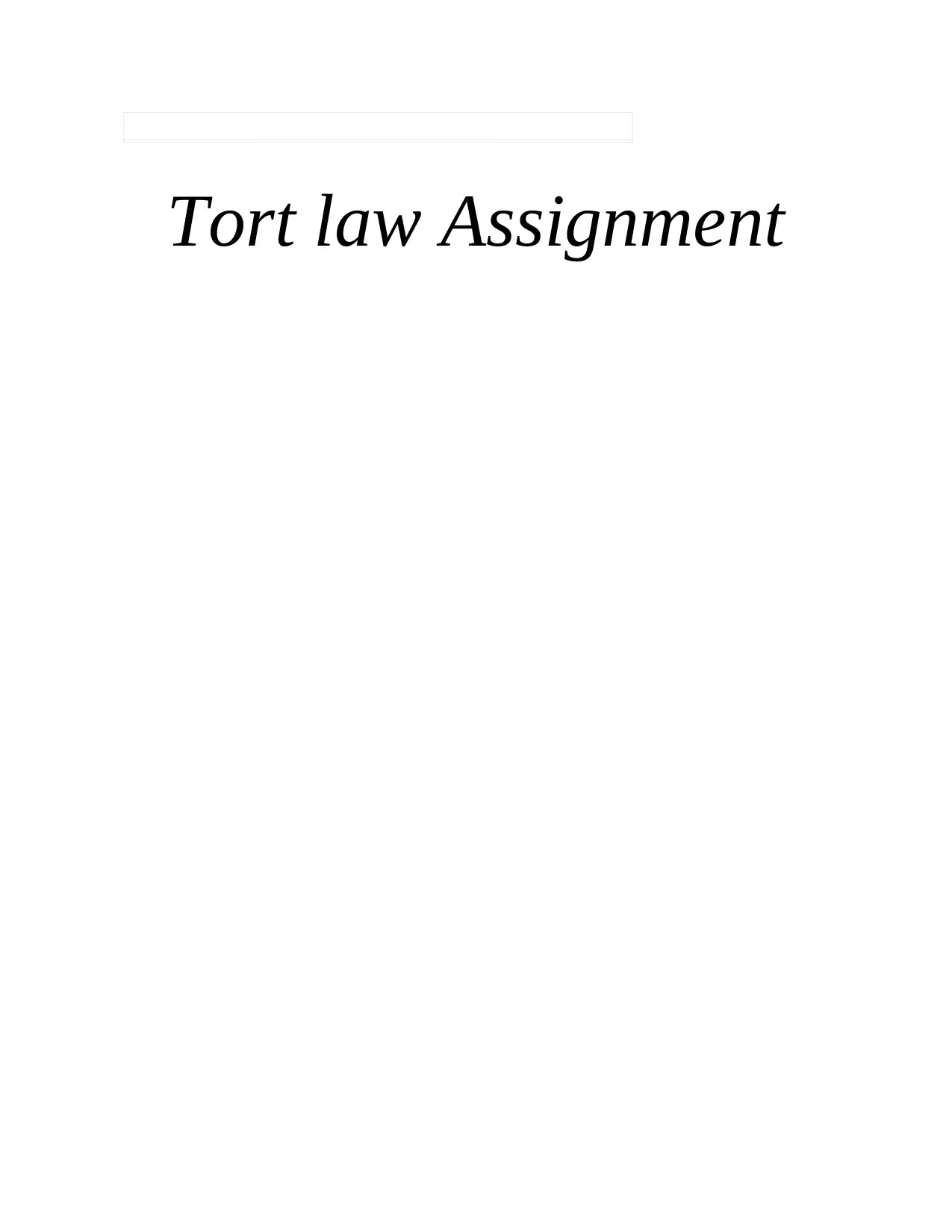
Tort law Assignment
Paraphrase This Document
Need a fresh take? Get an instant paraphrase of this document with our AI Paraphraser
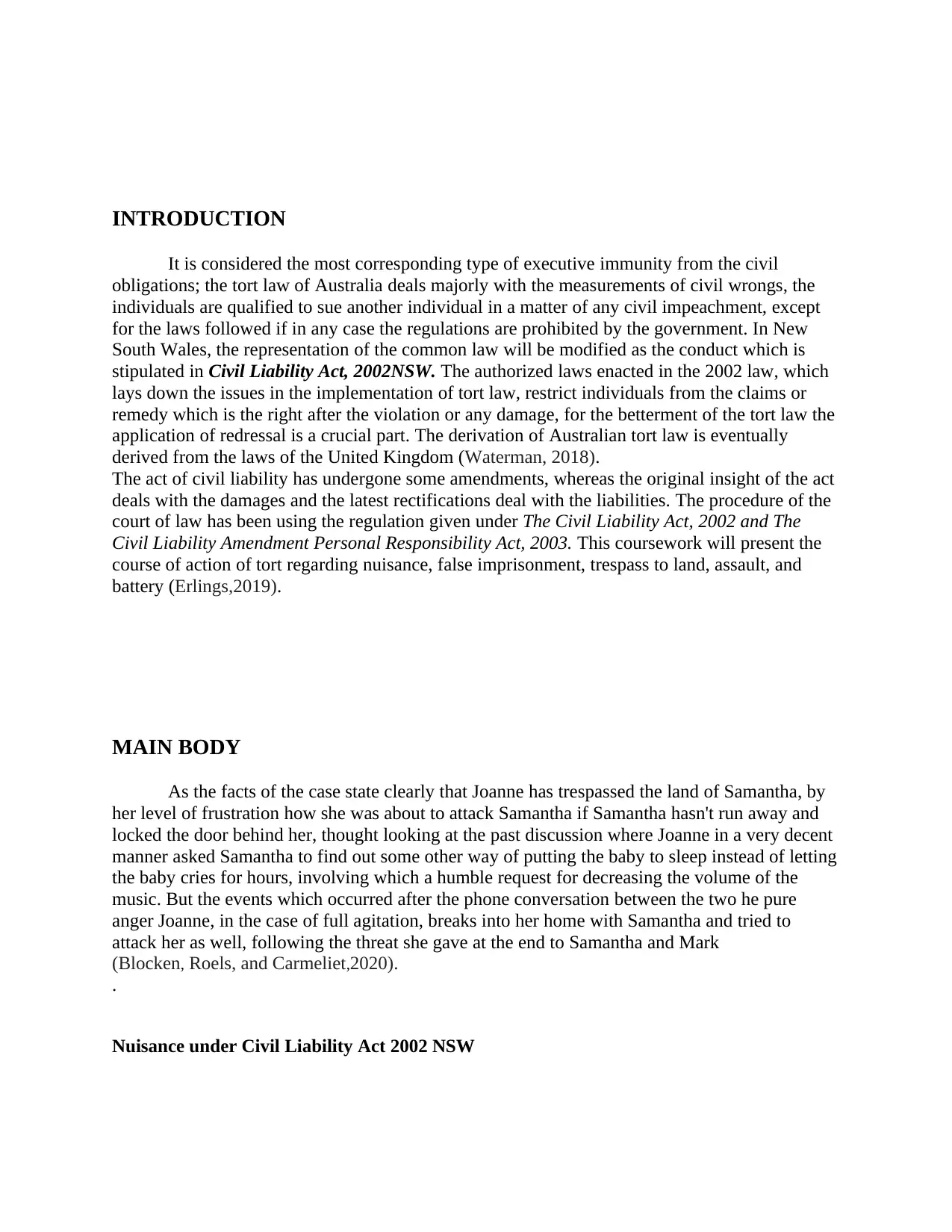
INTRODUCTION
It is considered the most corresponding type of executive immunity from the civil
obligations; the tort law of Australia deals majorly with the measurements of civil wrongs, the
individuals are qualified to sue another individual in a matter of any civil impeachment, except
for the laws followed if in any case the regulations are prohibited by the government. In New
South Wales, the representation of the common law will be modified as the conduct which is
stipulated in Civil Liability Act, 2002NSW. The authorized laws enacted in the 2002 law, which
lays down the issues in the implementation of tort law, restrict individuals from the claims or
remedy which is the right after the violation or any damage, for the betterment of the tort law the
application of redressal is a crucial part. The derivation of Australian tort law is eventually
derived from the laws of the United Kingdom (Waterman, 2018).
The act of civil liability has undergone some amendments, whereas the original insight of the act
deals with the damages and the latest rectifications deal with the liabilities. The procedure of the
court of law has been using the regulation given under The Civil Liability Act, 2002 and The
Civil Liability Amendment Personal Responsibility Act, 2003. This coursework will present the
course of action of tort regarding nuisance, false imprisonment, trespass to land, assault, and
battery (Erlings,2019).
MAIN BODY
As the facts of the case state clearly that Joanne has trespassed the land of Samantha, by
her level of frustration how she was about to attack Samantha if Samantha hasn't run away and
locked the door behind her, thought looking at the past discussion where Joanne in a very decent
manner asked Samantha to find out some other way of putting the baby to sleep instead of letting
the baby cries for hours, involving which a humble request for decreasing the volume of the
music. But the events which occurred after the phone conversation between the two he pure
anger Joanne, in the case of full agitation, breaks into her home with Samantha and tried to
attack her as well, following the threat she gave at the end to Samantha and Mark
(Blocken, Roels, and Carmeliet,2020).
.
Nuisance under Civil Liability Act 2002 NSW
It is considered the most corresponding type of executive immunity from the civil
obligations; the tort law of Australia deals majorly with the measurements of civil wrongs, the
individuals are qualified to sue another individual in a matter of any civil impeachment, except
for the laws followed if in any case the regulations are prohibited by the government. In New
South Wales, the representation of the common law will be modified as the conduct which is
stipulated in Civil Liability Act, 2002NSW. The authorized laws enacted in the 2002 law, which
lays down the issues in the implementation of tort law, restrict individuals from the claims or
remedy which is the right after the violation or any damage, for the betterment of the tort law the
application of redressal is a crucial part. The derivation of Australian tort law is eventually
derived from the laws of the United Kingdom (Waterman, 2018).
The act of civil liability has undergone some amendments, whereas the original insight of the act
deals with the damages and the latest rectifications deal with the liabilities. The procedure of the
court of law has been using the regulation given under The Civil Liability Act, 2002 and The
Civil Liability Amendment Personal Responsibility Act, 2003. This coursework will present the
course of action of tort regarding nuisance, false imprisonment, trespass to land, assault, and
battery (Erlings,2019).
MAIN BODY
As the facts of the case state clearly that Joanne has trespassed the land of Samantha, by
her level of frustration how she was about to attack Samantha if Samantha hasn't run away and
locked the door behind her, thought looking at the past discussion where Joanne in a very decent
manner asked Samantha to find out some other way of putting the baby to sleep instead of letting
the baby cries for hours, involving which a humble request for decreasing the volume of the
music. But the events which occurred after the phone conversation between the two he pure
anger Joanne, in the case of full agitation, breaks into her home with Samantha and tried to
attack her as well, following the threat she gave at the end to Samantha and Mark
(Blocken, Roels, and Carmeliet,2020).
.
Nuisance under Civil Liability Act 2002 NSW
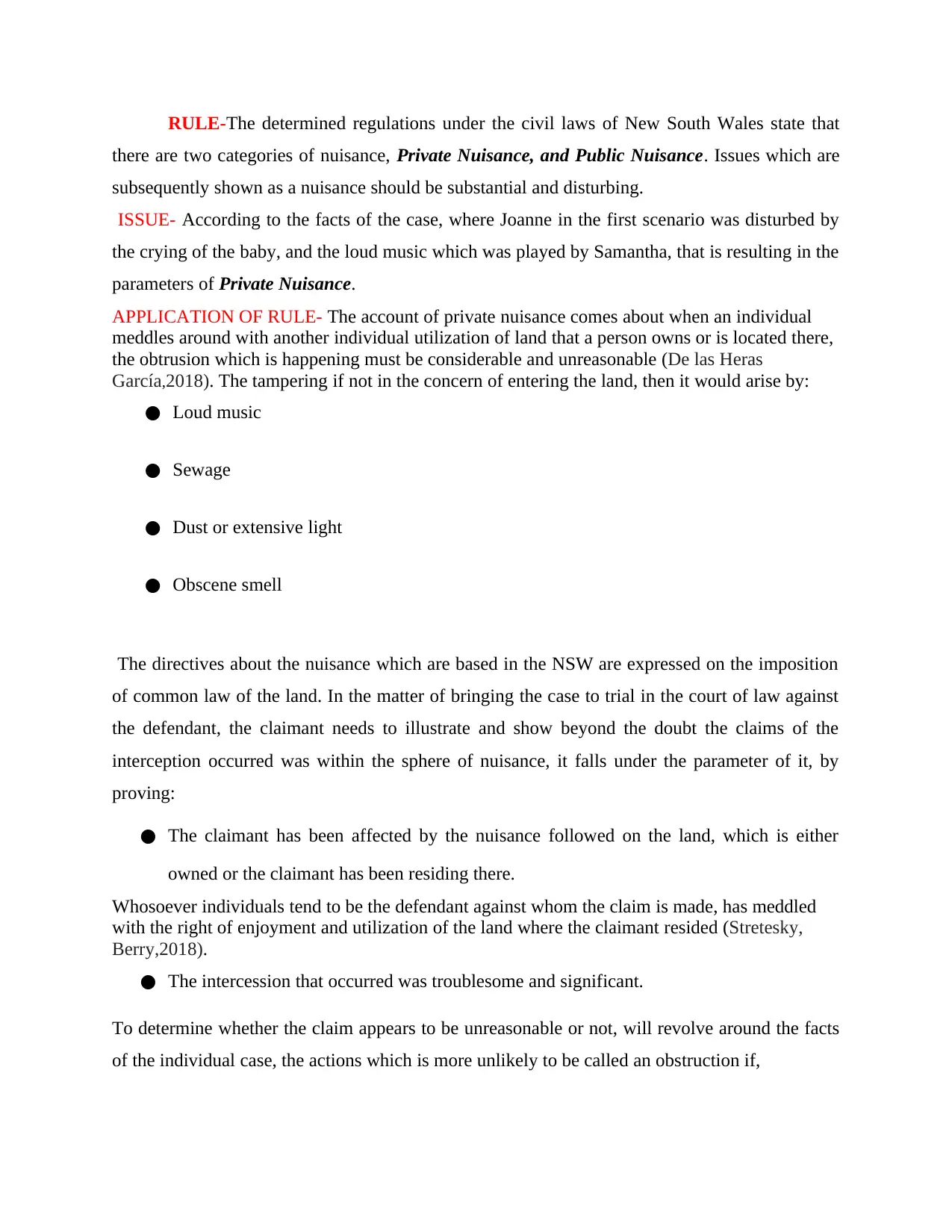
RULE-The determined regulations under the civil laws of New South Wales state that
there are two categories of nuisance, Private Nuisance, and Public Nuisance. Issues which are
subsequently shown as a nuisance should be substantial and disturbing.
ISSUE- According to the facts of the case, where Joanne in the first scenario was disturbed by
the crying of the baby, and the loud music which was played by Samantha, that is resulting in the
parameters of Private Nuisance.
APPLICATION OF RULE- The account of private nuisance comes about when an individual
meddles around with another individual utilization of land that a person owns or is located there,
the obtrusion which is happening must be considerable and unreasonable (De las Heras
García,2018). The tampering if not in the concern of entering the land, then it would arise by:
● Loud music
● Sewage
● Dust or extensive light
● Obscene smell
The directives about the nuisance which are based in the NSW are expressed on the imposition
of common law of the land. In the matter of bringing the case to trial in the court of law against
the defendant, the claimant needs to illustrate and show beyond the doubt the claims of the
interception occurred was within the sphere of nuisance, it falls under the parameter of it, by
proving:
● The claimant has been affected by the nuisance followed on the land, which is either
owned or the claimant has been residing there.
Whosoever individuals tend to be the defendant against whom the claim is made, has meddled
with the right of enjoyment and utilization of the land where the claimant resided (Stretesky,
Berry,2018).
● The intercession that occurred was troublesome and significant.
To determine whether the claim appears to be unreasonable or not, will revolve around the facts
of the individual case, the actions which is more unlikely to be called an obstruction if,
there are two categories of nuisance, Private Nuisance, and Public Nuisance. Issues which are
subsequently shown as a nuisance should be substantial and disturbing.
ISSUE- According to the facts of the case, where Joanne in the first scenario was disturbed by
the crying of the baby, and the loud music which was played by Samantha, that is resulting in the
parameters of Private Nuisance.
APPLICATION OF RULE- The account of private nuisance comes about when an individual
meddles around with another individual utilization of land that a person owns or is located there,
the obtrusion which is happening must be considerable and unreasonable (De las Heras
García,2018). The tampering if not in the concern of entering the land, then it would arise by:
● Loud music
● Sewage
● Dust or extensive light
● Obscene smell
The directives about the nuisance which are based in the NSW are expressed on the imposition
of common law of the land. In the matter of bringing the case to trial in the court of law against
the defendant, the claimant needs to illustrate and show beyond the doubt the claims of the
interception occurred was within the sphere of nuisance, it falls under the parameter of it, by
proving:
● The claimant has been affected by the nuisance followed on the land, which is either
owned or the claimant has been residing there.
Whosoever individuals tend to be the defendant against whom the claim is made, has meddled
with the right of enjoyment and utilization of the land where the claimant resided (Stretesky,
Berry,2018).
● The intercession that occurred was troublesome and significant.
To determine whether the claim appears to be unreasonable or not, will revolve around the facts
of the individual case, the actions which is more unlikely to be called an obstruction if,
⊘ This is a preview!⊘
Do you want full access?
Subscribe today to unlock all pages.

Trusted by 1+ million students worldwide
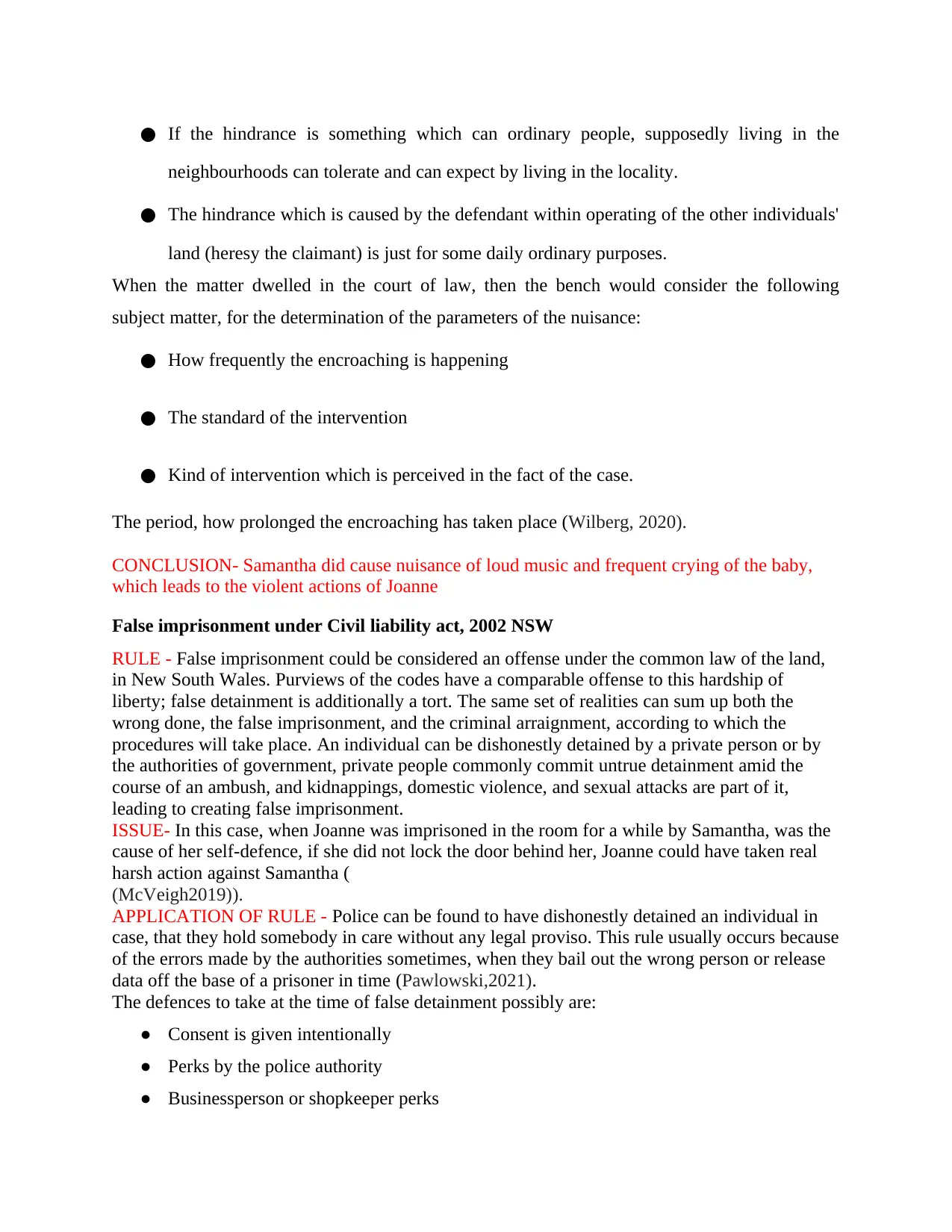
● If the hindrance is something which can ordinary people, supposedly living in the
neighbourhoods can tolerate and can expect by living in the locality.
● The hindrance which is caused by the defendant within operating of the other individuals'
land (heresy the claimant) is just for some daily ordinary purposes.
When the matter dwelled in the court of law, then the bench would consider the following
subject matter, for the determination of the parameters of the nuisance:
● How frequently the encroaching is happening
● The standard of the intervention
● Kind of intervention which is perceived in the fact of the case.
The period, how prolonged the encroaching has taken place (Wilberg, 2020).
CONCLUSION- Samantha did cause nuisance of loud music and frequent crying of the baby,
which leads to the violent actions of Joanne
False imprisonment under Civil liability act, 2002 NSW
RULE - False imprisonment could be considered an offense under the common law of the land,
in New South Wales. Purviews of the codes have a comparable offense to this hardship of
liberty; false detainment is additionally a tort. The same set of realities can sum up both the
wrong done, the false imprisonment, and the criminal arraignment, according to which the
procedures will take place. An individual can be dishonestly detained by a private person or by
the authorities of government, private people commonly commit untrue detainment amid the
course of an ambush, and kidnappings, domestic violence, and sexual attacks are part of it,
leading to creating false imprisonment.
ISSUE- In this case, when Joanne was imprisoned in the room for a while by Samantha, was the
cause of her self-defence, if she did not lock the door behind her, Joanne could have taken real
harsh action against Samantha (
(McVeigh2019)).
APPLICATION OF RULE - Police can be found to have dishonestly detained an individual in
case, that they hold somebody in care without any legal proviso. This rule usually occurs because
of the errors made by the authorities sometimes, when they bail out the wrong person or release
data off the base of a prisoner in time (Pawlowski,2021).
The defences to take at the time of false detainment possibly are:
● Consent is given intentionally
● Perks by the police authority
● Businessperson or shopkeeper perks
neighbourhoods can tolerate and can expect by living in the locality.
● The hindrance which is caused by the defendant within operating of the other individuals'
land (heresy the claimant) is just for some daily ordinary purposes.
When the matter dwelled in the court of law, then the bench would consider the following
subject matter, for the determination of the parameters of the nuisance:
● How frequently the encroaching is happening
● The standard of the intervention
● Kind of intervention which is perceived in the fact of the case.
The period, how prolonged the encroaching has taken place (Wilberg, 2020).
CONCLUSION- Samantha did cause nuisance of loud music and frequent crying of the baby,
which leads to the violent actions of Joanne
False imprisonment under Civil liability act, 2002 NSW
RULE - False imprisonment could be considered an offense under the common law of the land,
in New South Wales. Purviews of the codes have a comparable offense to this hardship of
liberty; false detainment is additionally a tort. The same set of realities can sum up both the
wrong done, the false imprisonment, and the criminal arraignment, according to which the
procedures will take place. An individual can be dishonestly detained by a private person or by
the authorities of government, private people commonly commit untrue detainment amid the
course of an ambush, and kidnappings, domestic violence, and sexual attacks are part of it,
leading to creating false imprisonment.
ISSUE- In this case, when Joanne was imprisoned in the room for a while by Samantha, was the
cause of her self-defence, if she did not lock the door behind her, Joanne could have taken real
harsh action against Samantha (
(McVeigh2019)).
APPLICATION OF RULE - Police can be found to have dishonestly detained an individual in
case, that they hold somebody in care without any legal proviso. This rule usually occurs because
of the errors made by the authorities sometimes, when they bail out the wrong person or release
data off the base of a prisoner in time (Pawlowski,2021).
The defences to take at the time of false detainment possibly are:
● Consent is given intentionally
● Perks by the police authority
● Businessperson or shopkeeper perks
Paraphrase This Document
Need a fresh take? Get an instant paraphrase of this document with our AI Paraphraser

● The arrest of a citizen in protection or under serious circumstances
CONCLUSION- Joanne was detained in the room by Samantha, for avoiding the act of violence,
which was about to happen on the part of Joanne.
Assault and Battery under Civil Liability Act 2002, NSW
RULE- An assault is any coordinated and purposeful risk made by an individual that brings
about the offended party in sensible dread of an inescapable contact with the plaintiff individual,
either by a litigant or by a few individuals, as centring on the trepidation of looming contact.
Hence, the impact of the victim's intellect made by risk is the core, not whether the litigant had
the deliberate or implies to take it after it up. The objective required for the tort of assault is the
craving to stir an apprehend of physical contact, not fundamentally deliberate to dispense real
harm ((Conlon,2019)).
An act of savagery that is incurred by an individual which includes direct, deliberateness, or
wilful intrusion of the physical or mental capacity of that individual is called an intentional tort.
The three major deliberateness torts are ambush (assaulting an individual),
APPLICATION TO RULE - Battery (hurting an individual), and false imprisonment (keeping an
individual without their will). These methods of the reasoning behind intentional torts are that
the transgressor must compensate the casualty for the punishment of hurt. Misfortunate and harm
which the casualty endures as a result. Many states in Australia have enactment which prohibits
purpose acts that cause damage to an individual and so prohibit the restriction of grants of harm
for these acts. In the case of New South Wales, in section 3B of the civil liability act 2002
(NSW). This section states that the act will not apprehend the application of the act which is
done by an individual to cause damage or death. A critical view of this area was seen in the case
of Bujdoso v New South Wales, 2006, this case states a detainee was intentioned attacked by
several obscure aggressors while imprisoned in NSW jail. The offended (plaintiff) party claimed
against the state government, based on its disappointment to care to guarantee the plaintiff the
offended party was not injured. To begin with the moment the courts found that S3B (1),
connected was the offended party was intentioned ambushed by other inmates (Wilberg,2020).
And so the damages were assaulted by the common laws of the land. However, on request, this
held decision by the court of law was overturned, and the NSW court of appeal found that the
S3B(1) does not gather to be applied here, in this case, the obligation is for carelessness in
coming up short to avoid wounds, to boid the negligence being stubborn and not preventing the
intentional acts of some other individual. In order words, the NSW government authorities in the
state did not make the deliberateness act, their act of negligence (falling short to protect the
injured party), was not with the intention and thus the act will apply.
Cases of battery, are frequently wrongly alluded to as assault cases, even though two of them for
sure, go hand in hand, and are listened to within the county courts. Unavoidably, they include
troublesome genuine debate requiring the determination of broadly clashing forms as to what
happened amid a specific event or occasion. Whether domestic or probably not. The essential
purpose for the battery is basically, that the respondent must have expected the result of the
contact with the offended party. The respondent is required not to know that the contact is illegal.
CONCLUSION- Joanne was detained in the room by Samantha, for avoiding the act of violence,
which was about to happen on the part of Joanne.
Assault and Battery under Civil Liability Act 2002, NSW
RULE- An assault is any coordinated and purposeful risk made by an individual that brings
about the offended party in sensible dread of an inescapable contact with the plaintiff individual,
either by a litigant or by a few individuals, as centring on the trepidation of looming contact.
Hence, the impact of the victim's intellect made by risk is the core, not whether the litigant had
the deliberate or implies to take it after it up. The objective required for the tort of assault is the
craving to stir an apprehend of physical contact, not fundamentally deliberate to dispense real
harm ((Conlon,2019)).
An act of savagery that is incurred by an individual which includes direct, deliberateness, or
wilful intrusion of the physical or mental capacity of that individual is called an intentional tort.
The three major deliberateness torts are ambush (assaulting an individual),
APPLICATION TO RULE - Battery (hurting an individual), and false imprisonment (keeping an
individual without their will). These methods of the reasoning behind intentional torts are that
the transgressor must compensate the casualty for the punishment of hurt. Misfortunate and harm
which the casualty endures as a result. Many states in Australia have enactment which prohibits
purpose acts that cause damage to an individual and so prohibit the restriction of grants of harm
for these acts. In the case of New South Wales, in section 3B of the civil liability act 2002
(NSW). This section states that the act will not apprehend the application of the act which is
done by an individual to cause damage or death. A critical view of this area was seen in the case
of Bujdoso v New South Wales, 2006, this case states a detainee was intentioned attacked by
several obscure aggressors while imprisoned in NSW jail. The offended (plaintiff) party claimed
against the state government, based on its disappointment to care to guarantee the plaintiff the
offended party was not injured. To begin with the moment the courts found that S3B (1),
connected was the offended party was intentioned ambushed by other inmates (Wilberg,2020).
And so the damages were assaulted by the common laws of the land. However, on request, this
held decision by the court of law was overturned, and the NSW court of appeal found that the
S3B(1) does not gather to be applied here, in this case, the obligation is for carelessness in
coming up short to avoid wounds, to boid the negligence being stubborn and not preventing the
intentional acts of some other individual. In order words, the NSW government authorities in the
state did not make the deliberateness act, their act of negligence (falling short to protect the
injured party), was not with the intention and thus the act will apply.
Cases of battery, are frequently wrongly alluded to as assault cases, even though two of them for
sure, go hand in hand, and are listened to within the county courts. Unavoidably, they include
troublesome genuine debate requiring the determination of broadly clashing forms as to what
happened amid a specific event or occasion. Whether domestic or probably not. The essential
purpose for the battery is basically, that the respondent must have expected the result of the
contact with the offended party. The respondent is required not to know that the contact is illegal.
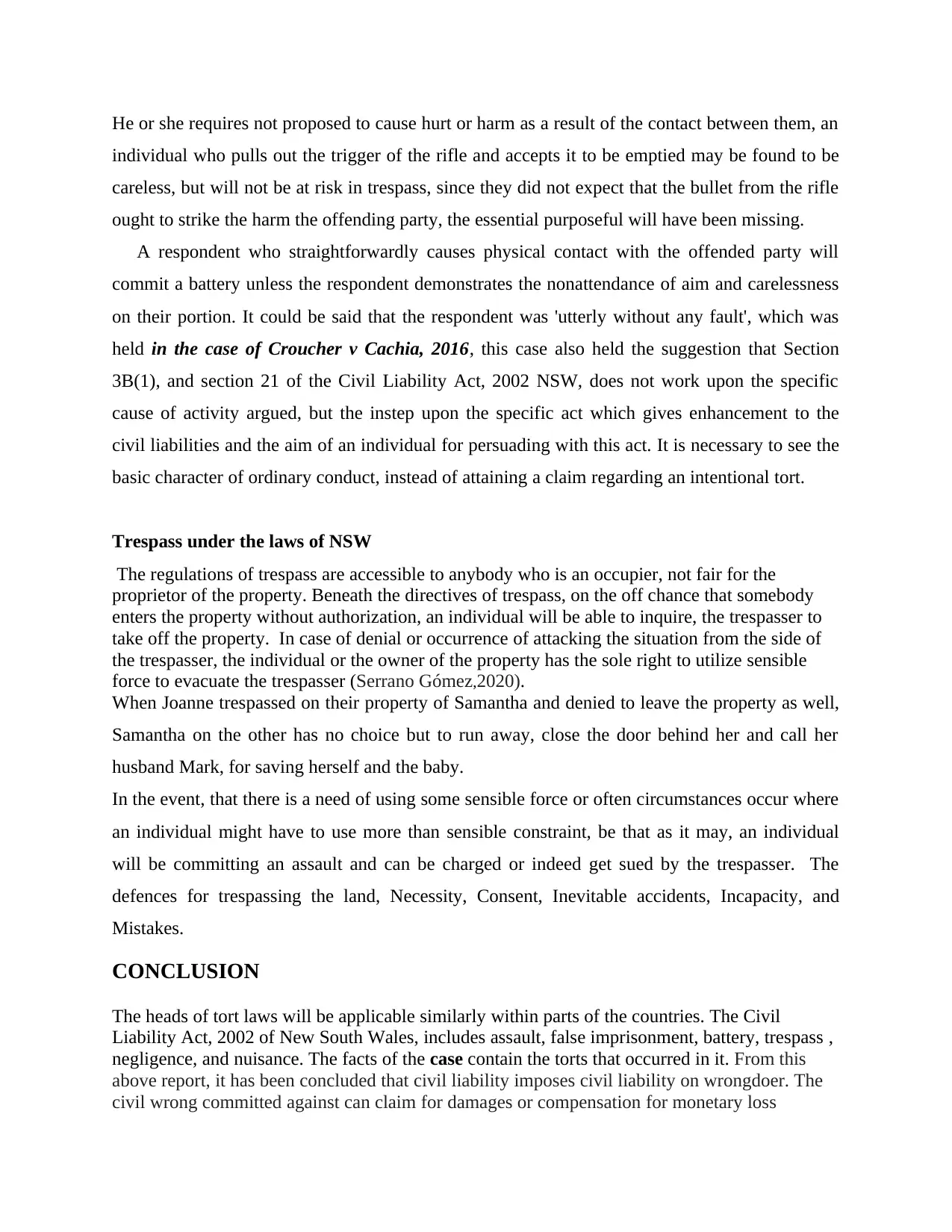
He or she requires not proposed to cause hurt or harm as a result of the contact between them, an
individual who pulls out the trigger of the rifle and accepts it to be emptied may be found to be
careless, but will not be at risk in trespass, since they did not expect that the bullet from the rifle
ought to strike the harm the offending party, the essential purposeful will have been missing.
A respondent who straightforwardly causes physical contact with the offended party will
commit a battery unless the respondent demonstrates the nonattendance of aim and carelessness
on their portion. It could be said that the respondent was 'utterly without any fault', which was
held in the case of Croucher v Cachia, 2016, this case also held the suggestion that Section
3B(1), and section 21 of the Civil Liability Act, 2002 NSW, does not work upon the specific
cause of activity argued, but the instep upon the specific act which gives enhancement to the
civil liabilities and the aim of an individual for persuading with this act. It is necessary to see the
basic character of ordinary conduct, instead of attaining a claim regarding an intentional tort.
Trespass under the laws of NSW
The regulations of trespass are accessible to anybody who is an occupier, not fair for the
proprietor of the property. Beneath the directives of trespass, on the off chance that somebody
enters the property without authorization, an individual will be able to inquire, the trespasser to
take off the property. In case of denial or occurrence of attacking the situation from the side of
the trespasser, the individual or the owner of the property has the sole right to utilize sensible
force to evacuate the trespasser (Serrano Gómez,2020).
When Joanne trespassed on their property of Samantha and denied to leave the property as well,
Samantha on the other has no choice but to run away, close the door behind her and call her
husband Mark, for saving herself and the baby.
In the event, that there is a need of using some sensible force or often circumstances occur where
an individual might have to use more than sensible constraint, be that as it may, an individual
will be committing an assault and can be charged or indeed get sued by the trespasser. The
defences for trespassing the land, Necessity, Consent, Inevitable accidents, Incapacity, and
Mistakes.
CONCLUSION
The heads of tort laws will be applicable similarly within parts of the countries. The Civil
Liability Act, 2002 of New South Wales, includes assault, false imprisonment, battery, trespass ,
negligence, and nuisance. The facts of the case contain the torts that occurred in it. From this
above report, it has been concluded that civil liability imposes civil liability on wrongdoer. The
civil wrong committed against can claim for damages or compensation for monetary loss
individual who pulls out the trigger of the rifle and accepts it to be emptied may be found to be
careless, but will not be at risk in trespass, since they did not expect that the bullet from the rifle
ought to strike the harm the offending party, the essential purposeful will have been missing.
A respondent who straightforwardly causes physical contact with the offended party will
commit a battery unless the respondent demonstrates the nonattendance of aim and carelessness
on their portion. It could be said that the respondent was 'utterly without any fault', which was
held in the case of Croucher v Cachia, 2016, this case also held the suggestion that Section
3B(1), and section 21 of the Civil Liability Act, 2002 NSW, does not work upon the specific
cause of activity argued, but the instep upon the specific act which gives enhancement to the
civil liabilities and the aim of an individual for persuading with this act. It is necessary to see the
basic character of ordinary conduct, instead of attaining a claim regarding an intentional tort.
Trespass under the laws of NSW
The regulations of trespass are accessible to anybody who is an occupier, not fair for the
proprietor of the property. Beneath the directives of trespass, on the off chance that somebody
enters the property without authorization, an individual will be able to inquire, the trespasser to
take off the property. In case of denial or occurrence of attacking the situation from the side of
the trespasser, the individual or the owner of the property has the sole right to utilize sensible
force to evacuate the trespasser (Serrano Gómez,2020).
When Joanne trespassed on their property of Samantha and denied to leave the property as well,
Samantha on the other has no choice but to run away, close the door behind her and call her
husband Mark, for saving herself and the baby.
In the event, that there is a need of using some sensible force or often circumstances occur where
an individual might have to use more than sensible constraint, be that as it may, an individual
will be committing an assault and can be charged or indeed get sued by the trespasser. The
defences for trespassing the land, Necessity, Consent, Inevitable accidents, Incapacity, and
Mistakes.
CONCLUSION
The heads of tort laws will be applicable similarly within parts of the countries. The Civil
Liability Act, 2002 of New South Wales, includes assault, false imprisonment, battery, trespass ,
negligence, and nuisance. The facts of the case contain the torts that occurred in it. From this
above report, it has been concluded that civil liability imposes civil liability on wrongdoer. The
civil wrong committed against can claim for damages or compensation for monetary loss
⊘ This is a preview!⊘
Do you want full access?
Subscribe today to unlock all pages.

Trusted by 1+ million students worldwide
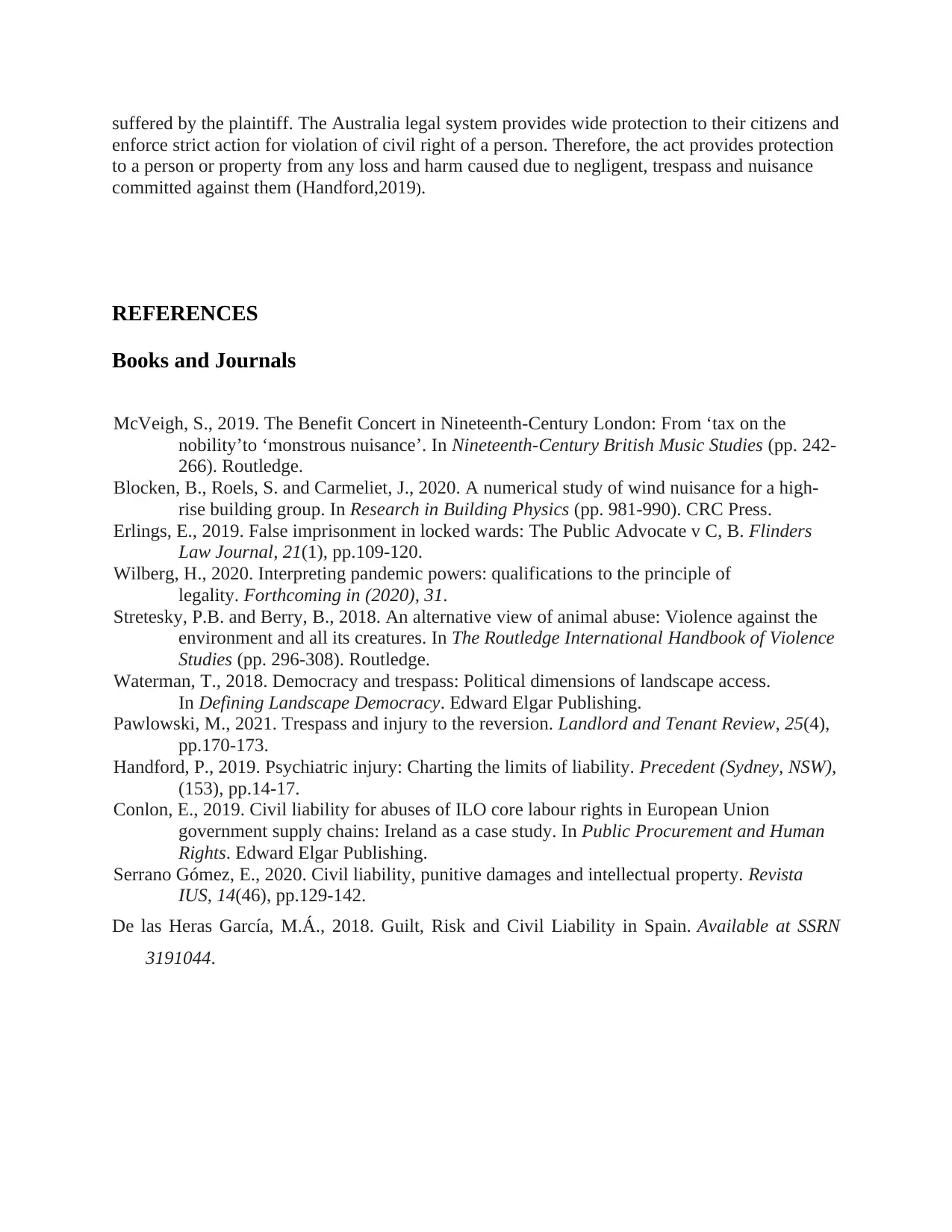
suffered by the plaintiff. The Australia legal system provides wide protection to their citizens and
enforce strict action for violation of civil right of a person. Therefore, the act provides protection
to a person or property from any loss and harm caused due to negligent, trespass and nuisance
committed against them (Handford,2019).
REFERENCES
Books and Journals
McVeigh, S., 2019. The Benefit Concert in Nineteenth-Century London: From ‘tax on the
nobility’to ‘monstrous nuisance’. In Nineteenth-Century British Music Studies (pp. 242-
266). Routledge.
Blocken, B., Roels, S. and Carmeliet, J., 2020. A numerical study of wind nuisance for a high-
rise building group. In Research in Building Physics (pp. 981-990). CRC Press.
Erlings, E., 2019. False imprisonment in locked wards: The Public Advocate v C, B. Flinders
Law Journal, 21(1), pp.109-120.
Wilberg, H., 2020. Interpreting pandemic powers: qualifications to the principle of
legality. Forthcoming in (2020), 31.
Stretesky, P.B. and Berry, B., 2018. An alternative view of animal abuse: Violence against the
environment and all its creatures. In The Routledge International Handbook of Violence
Studies (pp. 296-308). Routledge.
Waterman, T., 2018. Democracy and trespass: Political dimensions of landscape access.
In Defining Landscape Democracy. Edward Elgar Publishing.
Pawlowski, M., 2021. Trespass and injury to the reversion. Landlord and Tenant Review, 25(4),
pp.170-173.
Handford, P., 2019. Psychiatric injury: Charting the limits of liability. Precedent (Sydney, NSW),
(153), pp.14-17.
Conlon, E., 2019. Civil liability for abuses of ILO core labour rights in European Union
government supply chains: Ireland as a case study. In Public Procurement and Human
Rights. Edward Elgar Publishing.
Serrano Gómez, E., 2020. Civil liability, punitive damages and intellectual property. Revista
IUS, 14(46), pp.129-142.
De las Heras García, M.Á., 2018. Guilt, Risk and Civil Liability in Spain. Available at SSRN
3191044.
enforce strict action for violation of civil right of a person. Therefore, the act provides protection
to a person or property from any loss and harm caused due to negligent, trespass and nuisance
committed against them (Handford,2019).
REFERENCES
Books and Journals
McVeigh, S., 2019. The Benefit Concert in Nineteenth-Century London: From ‘tax on the
nobility’to ‘monstrous nuisance’. In Nineteenth-Century British Music Studies (pp. 242-
266). Routledge.
Blocken, B., Roels, S. and Carmeliet, J., 2020. A numerical study of wind nuisance for a high-
rise building group. In Research in Building Physics (pp. 981-990). CRC Press.
Erlings, E., 2019. False imprisonment in locked wards: The Public Advocate v C, B. Flinders
Law Journal, 21(1), pp.109-120.
Wilberg, H., 2020. Interpreting pandemic powers: qualifications to the principle of
legality. Forthcoming in (2020), 31.
Stretesky, P.B. and Berry, B., 2018. An alternative view of animal abuse: Violence against the
environment and all its creatures. In The Routledge International Handbook of Violence
Studies (pp. 296-308). Routledge.
Waterman, T., 2018. Democracy and trespass: Political dimensions of landscape access.
In Defining Landscape Democracy. Edward Elgar Publishing.
Pawlowski, M., 2021. Trespass and injury to the reversion. Landlord and Tenant Review, 25(4),
pp.170-173.
Handford, P., 2019. Psychiatric injury: Charting the limits of liability. Precedent (Sydney, NSW),
(153), pp.14-17.
Conlon, E., 2019. Civil liability for abuses of ILO core labour rights in European Union
government supply chains: Ireland as a case study. In Public Procurement and Human
Rights. Edward Elgar Publishing.
Serrano Gómez, E., 2020. Civil liability, punitive damages and intellectual property. Revista
IUS, 14(46), pp.129-142.
De las Heras García, M.Á., 2018. Guilt, Risk and Civil Liability in Spain. Available at SSRN
3191044.
1 out of 7
Related Documents
Your All-in-One AI-Powered Toolkit for Academic Success.
+13062052269
info@desklib.com
Available 24*7 on WhatsApp / Email
![[object Object]](/_next/static/media/star-bottom.7253800d.svg)
Unlock your academic potential
Copyright © 2020–2025 A2Z Services. All Rights Reserved. Developed and managed by ZUCOL.



